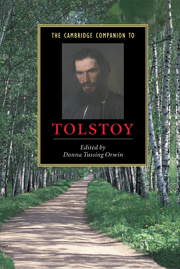Book contents
- Frontmatter
- Chronology
- Introduction
- Part 1 The three novels
- Part 2 Genres
- Part 3 General topics
- 7 The development of style and theme in Tolstoy
- 8 History and autobiography in Tolstoy
- 9 Women, sexuality, and the family in Tolstoy
- 10 Tolstoy in the twentieth century
- 11 Courage in Tolstoy
- 12 Tolstoy’s aesthetics
- Guide to further reading
- Index to Tolstoy’s works and characters
- Generel Index
12 - Tolstoy’s aesthetics
from Part 3 - General topics
Published online by Cambridge University Press: 28 May 2006
- Frontmatter
- Chronology
- Introduction
- Part 1 The three novels
- Part 2 Genres
- Part 3 General topics
- 7 The development of style and theme in Tolstoy
- 8 History and autobiography in Tolstoy
- 9 Women, sexuality, and the family in Tolstoy
- 10 Tolstoy in the twentieth century
- 11 Courage in Tolstoy
- 12 Tolstoy’s aesthetics
- Guide to further reading
- Index to Tolstoy’s works and characters
- Generel Index
Summary
Among the many definitions and defenses of art produced by the world’s great practicing artists, Tolstoy’s is surely one of the most peculiar. It is curiously selfless. In fact, so far is Tolstoy from using such a forum to defend his own practice that in his most programmatic statement on aesthetics, the 1897 treatise What is Art?, he consigns his own acclaimed masterworks to the category of bad art. The company, to be sure, is superb: Shakespeare, Dante, much of Pushkin, and almost all of Beethoven and Wagner are also so classified. Tolstoy’s eccentric and provocative judgments on individual world-class artists cannot be judged, however, apart from his larger vision of art’s place in the human world. That worldview can be (and by many, has been) rejected, but my purpose in the present discussion is to examine it from within and on its own terms. For there is a surprising toughness, subtlety, and integrity to many components of this vision, which Tolstoy’s categorical tone often masks.
Tolstoy’s aesthetic convictions naturally evolved during his long, well-documented life, and the degree of their continuity across his crisis watershed of the early 1880s remains a matter of debate. His letters and diaries over half a century record hundreds of instances of excellent practical criticism and intuitive judgments that fit under no theoretical rubric. In the 1850s, defining himself against the new generation of materialist civic critics, Tolstoy briefly endorsed the idea of art as an autonomous medium that serves the artist’s own inner strivings. His own views began to take stable form, however, only during his radical pedagogical experiments with peasant children at Iasnaia Poliana in the early 1860s. From that point on, a growing sense that human experience must be a unity, and that human relations must unify, led Tolstoy to cleanse and categorize his aesthetic views.
- Type
- Chapter
- Information
- The Cambridge Companion to Tolstoy , pp. 237 - 251Publisher: Cambridge University PressPrint publication year: 2002
- 4
- Cited by



